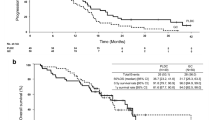Abstract
Purpose: To compare the in vitro cytotoxicity of nedaplatin, an investigational platinum analog, with that of the standard platinum agents, cisplatin and carboplatin, against fresh human, epithelial ovarian cancers. Methods: The Hamburger-Salmon human tumor colony-forming assay (HTCA) was used to measure the chemosensitivity of 36 fresh tumor samples obtained during initial exploratory laparotomy from patients with newly diagnosed stage III – IV epithelial ovarian cancer who had received no prior chemotherapy or radiation therapy. Tumor samples were exposed to the platinum analogs for 1 h at concentrations of 10 and 100 μg/ml of nedaplatin and cisplatin and 100 and 1000 μg/ml of carboplatin. The resulting survival data were used to estimate the IC50 (drug concentration associated with 50% inhibition of tumor colony forming units, TCFUs) of each of the platinum analogs for each of the tumor samples, as well as the estimated survival following exposure to clinically achievable drug levels (i.e. the ultrafiltrable platinum area under the plasma disappearance curve, AUC, achieved in cancer patients following administration of standard or phase II doses). Results: At the lowest concentration tested (i.e. 10 μg/ml nedaplatin and cisplatin and 100 μg/ml carboplatin) the percentages of tumor samples which were sensitive (as defined by 50% or less survival of TCFUs as compared with controls) were 42, 50, and 40% for nedaplatin, cisplatin and carboplatin, respectively. The median IC50 values were 28.5, 12 and 121 μg/ml for nedaplatin, cisplatin and carboplatin, respectively. The estimated percentage of tumors sensitive to clinically achievable dose levels was 42% for nedaplatin and 36% for cisplatin and carboplatin. Nedaplatin and carboplatin proved relatively crossresistant with cisplatin in vitro; of the 18 tumor samples which were resistant to cisplatin, only 5 (28%) were sensitive to nedaplatin and 3 of 17 (18%) were sensitive to carboplatin. Conclusion: Nedaplatin was associated with cytotoxicity similar to cisplatin and carboplatin in this study. Although nedaplatin appears to be crossresistant with cisplatin, its high rate of in vitro cytotoxicity, relative lack of neurotoxicity and nephrotoxicity, and large in vivo bioavailability establish nedaplatin as a promising platinum analog for further clinical development as a salvage and primary chemotherapeutic agent for patients with advanced ovarian cancer.
Similar content being viewed by others
Author information
Authors and Affiliations
Additional information
Received: 7 November 1995 / Accepted: 20 September 1996
Rights and permissions
About this article
Cite this article
Alberts, D., Fanta, P., Running, K. et al. In vitro phase II comparison of the cytotoxicity of a novel platinum analog, nedaplatin (254-S), with that of cisplatin and carboplatin against fresh, human ovarian cancers. Cancer Chemother Pharmacol 39, 493–497 (1997). https://doi.org/10.1007/s002800050604
Issue Date:
DOI: https://doi.org/10.1007/s002800050604




